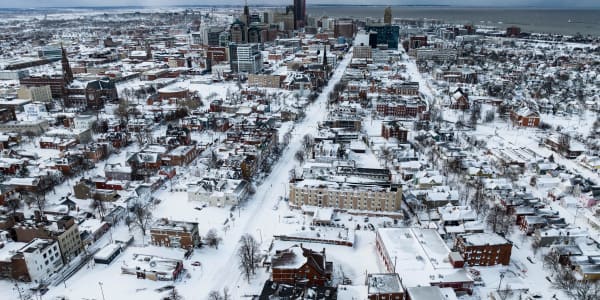While undocumented workers are tucked into every state and nearly every corner of the U.S. economy, states with more unauthorized workers would be hit hardest by a so-called Trump wall and fewer illegal migrants.
The idea to deport millions of immigrants and erect a wall along the southern border of the United States with Mexico is an anchor in Donald Trump's presidential run. Extracting millions of unauthorized workers from the U.S. labor force and making it harder for Mexican consumers to travel to the United States to spend money are policies of concern to economists.
"The impacts wouldn't be uniform," said Timothy Kehoe, an economics professor at the University of Minnesota and an advisor at the Federal Reserve Bank of Minneapolis. "Some states, some industries would be hurt more than others. But it would be tremendously disruptive."
States with the highest population of unauthorized migrants, from one to five, are: California, Texas, New York, Florida and Illinois, according to the Migration Policy Institute. Some 58 percent of all unauthorized U.S. migrants live in the top five states, said Jeanne Batalova, senior policy analyst at the Migration Policy Institute.
While the total number of unauthorized migrants in the United States (including both workers and non-workers) is around 10.2 million, roughly 7.2 million unauthorized workers are in the U.S. labor force, according to January 2015 data from the Migration Policy Institute. (The data is based on analysis from the Census Bureau's 2013 American Community Survey.) That's roughly 5 percent of the U.S. workforce.
In California, Texas and Illinois more than 70 percent of all undocumented migrants come from a single country — Mexico. And across the United States, including the top five states, some 49 percent of unauthorized migrants have lived in America for more than a decade.
"It's an established population," Batalova said. "They're ingrained in the economy in the states of which they reside."
Where they work
Unauthorized workers in the top five states work in industries that rely on low-skilled cheap labor to drive down costs and keep consumer prices lower, from food to housing. Here's a snapshot:
California: Predominately in hospitality (the grouping includes accommodation, food services and tourism), manufacturing, construction and agriculture.
Texas: Typical for the South, construction is a big employer. Other key employers are hospitality and other services.
New York: Hospitality, construction, education and health care.
Florida: Construction, professional business services (for example, as a janitor in a research facility) and hospitality.
Illinois: Like other Midwestern states, manufacturing employs many unauthorized workers, followed by the hospitality sector.
Source: Migration Policy Institute, U.S. Census Bureau
The economic consequences of removing these workers from the labor force could be potentially dire.
"Without new workers who would take their jobs, it could cause havoc in those industries, at least in the near term," Batalova said.
Beyond the threat of a Trump wall, a deadlocked Supreme Court in June failed to revive President Obama's plan to protect roughly 4 million undocumented immigrants from deportation. "It put us back into legal and political limbo," Batalova said.
If and when deportation of millions of undocumented immigrants is triggered by a Supreme Court ruling or a so-called Trump wall, the mere possibility of enforced deportation could influence many undocumented workers to not show up for work in key industries and derail state economies, Batalova said.
This trend already has emerged in education and schools as undocumented parents hold back their children from school, perceiving a threat of immigration raids. "It's that perception of threat that is still real for many people," she said.
Beyond cheap labor
Trump's political rise shows that a top concern for many Americans is that immigrants take jobs and depress the wages of similarly skilled, native workers. Immigration economist George Borjas at the Harvard Kennedy School has analyzed how much immigration can lower the wage of competing workers. A 10 percent increase in worker supply can reduce wages by 3 percent to 4 percent, according to his influential research.
But the debate goes beyond wages. Research conducted by William Olney, associate professor of economics at Williams College, has found the availability of more low-skilled workers can prompt existing U.S. businesses to expand operations. Immigration also increases the number of small businesses in mobile, low-skilled intensive industries, such as manufacturing, wholesale trade and transportation and warehousing.
Total immigrants, both legal and unauthorized, comprise roughly 17 percent, or more than 26 million, of the civilian U.S. workforce.
"It's very difficult to imagine the economy functioning without this workforce, which has grown so large over a long period of time," said Pia Orrenius, senior economist at the Federal Reserve Bank of Dallas.
Fewer immigrants could mean lowered rates of U.S. productivity, less innovation and fewer small businesses that are created.
"It would create enormous problems that economists would call a recession," Kehoe said.
It's very difficult to imagine the economy functioning without this workforce.Pia Orreniussenior economist at the Federal Reserve Bank of Dallas
U.S. innovation can also get a boost from immigrant college graduates. Given immigrants' strong grounding in science and engineering education, they patent at a higher rate than native workers. A 1 percentage-point increase in immigrant college graduates' population share increases patents per capita by 9 percent to 18 percent, according to research published in the "American Economic Journal: Macroeconomics in 2010." Even immigrants who do not patent themselves may increase innovation by providing complementary skills to inventors, such as entrepreneurship.
Olney and other entrepreneurship researchers have found high levels of business creation among immigrants, especially first-generation immigrants who were born elsewhere and later moved to the United States.
First-generation immigrant entrepreneurs launch and run new businesses at twice the rate of even second-generation immigrants, according to a 2012 U.S. Global Entrepreneurship Monitor report, led by several researchers, including Donna Kelley of Babson College in Massachusetts.
The Mexican fallacy
For all the talk about cracking down on unauthorized Mexicans crossing the border, illegal crossings have been declining amid intensified enforcement and rising smuggling fees.
The probability of an undocumented migrant taking a first trip to America has dropped to near zero, according to the Mexican Migration Project. They track Mexican migration to the United States.
The number of Mexican immigrants living illegally in the United States has also declined, down by roughly 1 million since 2007 to around 5.6 million in 2014, according to data from the Pew Research Center.
In more recent years, Central Americans are among those apprehended along the border. More non-Mexicans than Mexicans were apprehended at U.S. borders in 2014, the first time on record this has happened, according to Pew.
Focusing on one U.S. border community can help show how a possible wall could stall economic activity.
With an area population of roughly 831,000 and growing, the economic fate of McAllen, Texas, and its surrounding communities are linked to the Mexican city of Reynosa to the south. About one-third of McAllen's retail activity can be attributed to Mexican shoppers. And in Texas, residents pay no personal income tax. So retail sales, sales tax and foot traffic from shoppers across the border in Mexico are major economic drivers.
"Anything that impacts the sales tax has a direct impact on the financial strength of the city," said Keith Patridge, president and chief executive of the McAllen Economic Development Corporation.
For McAllen and other regional economies hinged on immigration flows, solutions to potential immigrant changes could include tweaking local incentives to continue to lure consumers and low-wage workers.
A large consumer economy question is also embedded in this issue for places like McAllen: Will Mexican shoppers want to come?
"What would impact our community is the psychological impact that it may have on the Mexico residents who are saying, 'Why do I want to go to the U.S. and shop?'" Patridge said. "Why do I want to go over there and buy if they're going to treat us like this?"
— Heesun Wee, special to CNBC.com





